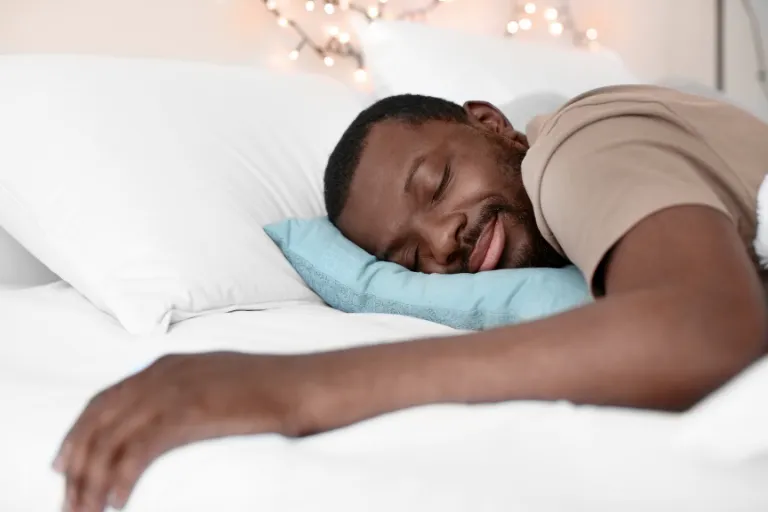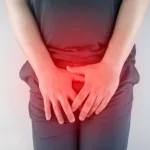Key Points
- Exposure to certain light wavelengths—especially blue and white light—can disrupt sleep by suppressing melatonin.
- Warm-toned lights, such as red or amber, are less likely to interfere with the body’s natural sleep rhythm.
- Even dim light during sleep can influence metabolism, heart health, and morning alertness.
- Optimizing your bedroom lighting can help restore your body’s natural sleep-wake balance.
When the Night Isn’t Dark Enough
Have you ever fallen asleep with a bedside lamp on—or scrolled your phone until your eyelids gave up—and still woke up feeling groggy? You’re not alone.
In a world of glowing screens, LED clocks, and streetlights that never dim, total darkness has become a luxury. But science suggests that even the faintest light at night can send powerful signals to the brain—sometimes enough to throw off our body’s natural sleep rhythms [1].
The Light–Sleep Connection: Why Darkness Still Matters
Sleep is a finely tuned biological process governed by light. Our internal clock, known as the circadian rhythm, relies on cues from light exposure to determine when to stay alert and when to rest. During the day, sunlight—particularly blue wavelengths—helps keep us awake and focused. But when those same wavelengths appear at night, they can suppress melatonin, the hormone responsible for signaling that it’s time to sleep [2].
Modern living has blurred that line. From late-night work sessions to ambient LED lighting, we’re surrounded by light that our bodies interpret as daytime. The result? Fragmented sleep, lower sleep quality, and in some cases, long-term health consequences like mood imbalances, metabolic disruption, and elevated heart rate variability [3].
What Science Reveals About Light Colours and Sleep
Not all light is created equal. The colour—or wavelength—of light determines how deeply it affects your brain’s sleep chemistry.
- Blue and White Light (460–480 nm):
These wavelengths are the strongest suppressors of melatonin. Found in smartphones, tablets, LED bulbs, and television screens, they can delay the onset of sleep and reduce overall sleep duration [4]. - Green Light (around 530 nm):
Though less disruptive than blue, green light can still delay circadian timing if exposure occurs before bedtime. - Red and Amber Light (around 600–700 nm):
These longer wavelengths have minimal impact on melatonin and are considered the most “sleep-friendly.” Studies suggest that red light may even promote relaxation and help maintain circadian stability when used at low intensity [5]. - Dim Light Exposure:
Even low-level light—such as a TV glow or a hallway night light—can alter sleep architecture, increasing nighttime awakenings and reducing slow-wave (deep) sleep [6].
In one 2022 study published in PNAS, researchers found that sleeping with even moderate ambient light raised nighttime heart rates and reduced insulin sensitivity the following morning—evidence that light exposure during sleep can disrupt both rest and metabolism [7].
Everyday Lighting Habits That Quietly Disrupt Sleep
Our homes are filled with invisible cues that tell the brain it’s daytime. A bright bathroom light before bed. The glow of a digital clock. Even the gentle standby light from a TV can interfere with melatonin rhythms.
Many people also scroll through their phones in bed, unaware that the concentrated blue light from the screen is signaling the brain to “stay awake.” Research shows that using blue-light–emitting devices within one hour of bedtime can delay sleep onset by up to 60 minutes [8].
Designing Your Environment for Better Sleep
You don’t have to live in darkness to sleep well—but you can make light work for you rather than against you.
1. Choose Warm-Toned Night Lights:
Opt for red or amber bulbs instead of white or blue ones. They provide gentle illumination without interfering with melatonin.
2. Dim Lights Two Hours Before Bed:
Lowering light intensity gradually cues your body that bedtime is approaching. Try using lamps or dimmers rather than overhead LEDs.
3. Use Blue Light Filters on Devices:
Activate “Night Shift” (iPhone), “Night Mode” (Android), or apps like f.lux to shift screen colour toward warmer tones after sunset.
4. Block Ambient Light During Sleep:
Blackout curtains, sleep masks, and unplugging small LED sources can help restore darkness.
5. Let in Morning Sunlight:
Natural daylight exposure upon waking helps reset the circadian rhythm and strengthens nighttime melatonin production.
By being intentional about light exposure—especially in the hour before bed—you can align your internal clock with nature’s rhythm, improving both sleep quality and next-day energy.
The Hidden Health Costs of Sleeping in Light
Beyond fatigue, poor light hygiene has ripple effects across multiple body systems. Disrupted circadian rhythms are linked to metabolic changes, depressive states, and cardiovascular stress. Studies suggest that people exposed to artificial light during sleep have a higher risk of weight gain, blood sugar irregularities, and reduced heart rate variability, a key measure of recovery and resilience [7].
Sleep, it turns out, isn’t just about closing your eyes—it’s about what your body senses in the dark.
Reclaiming the Night for Rest and Renewal
In a 24-hour world, darkness is becoming an endangered resource. But reclaiming it—even for a few hours each night—may be one of the simplest, most powerful ways to protect your health.
So tonight, when you reach for the lamp or your phone, remember: your body listens to the language of light. And it always tells the truth.
The article does not in any way constitute as medical advice. Please seek consultation with a licensed medical professional before starting any treatment. This website may receive commissions from the links or products mentioned in this article.
Subscribe for Free for more insightful health articles tailored to your needs.
Sources
- Harvard Health Publishing. (2019). Blue light has a dark side. https://www.health.harvard.edu
- National Institute of General Medical Sciences. (2021). Circadian Rhythms Fact Sheet. https://nigms.nih.gov
- American Academy of Sleep Medicine. (2022). Light Exposure and Sleep Health. https://aasm.org
- Chang, A. M., et al. (2015). Evening use of light-emitting eReaders negatively affects sleep. PNAS, 112(4), 1232–1237.
- Figueiro, M. G., & Rea, M. S. (2012). Short-wavelength light enhances alertness at night. Journal of the Society for Information Display.
- Cho, J. R., et al. (2018). Nighttime light exposure and sleep disturbances. Sleep Medicine Reviews.
- Chellappa, S. L., et al. (2022). Light exposure during sleep impairs metabolic and cardiovascular regulation. PNAS, 119(12), e2113290119.
- Heo, J., et al. (2021). Smartphone light exposure delays sleep onset in adults. Chronobiology International, 38(5), 734–743.




